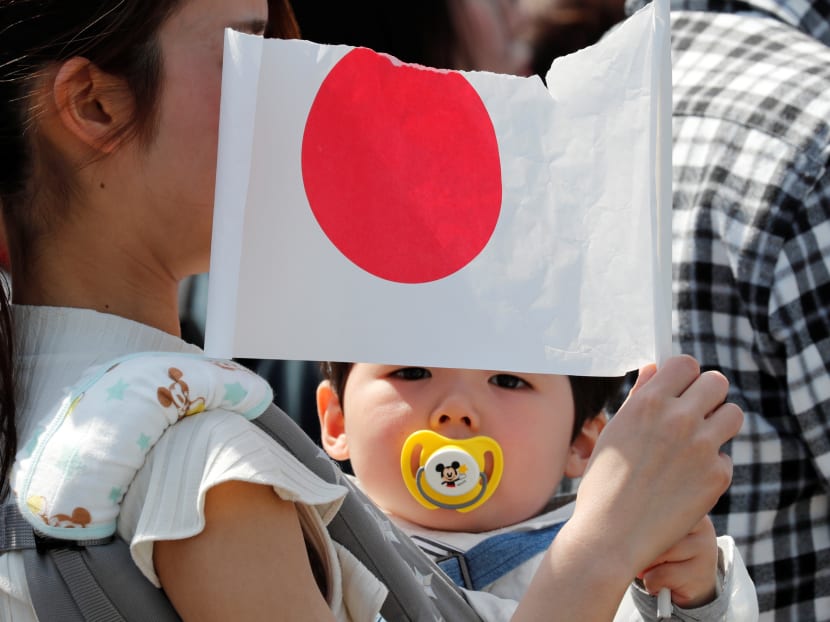Japan sees largest ever shrink in population size as birth numbers fall to lowest since 1874
TOKYO — Japan has 512,000 fewer people this year than last, according to an estimate released on Tuesday (Dec 24) by the country’s Ministry of Health, Labor and Welfare, marking the first time a shrink in population has crossed the half-million mark.

The number of babies born in Japan, which stood at 1,247,000 in 1989, has dropped by 30 per cent over the 30 years. The estimated 864,000 babies in 2019 will be the lowest since 1874.
TOKYO — Japan has 512,000 fewer people this year than last, according to an estimate released on Tuesday (Dec 24) by the country’s Ministry of Health, Labor and Welfare, marking the first time a shrink in population has crossed the half-million mark.
The numbers are the latest sign of Japan’s increasing demographic challenges.
The figure of newborns for the year is estimated at 864,000, down 54,000 from a year earlier. This is the biggest decline in births since 1975, driven by fewer women aged 25 to 39, said a ministry official in charge of compiling the data.
At 864,000 Japan will see its lowest number of babies since 1874, when the population was about 70 per cent smaller than its current 124 million.
The total number of deaths, on the other hand, is increasing. This year, the figure is expected to reach almost 1.4 million, the highest level since the end of World War II, a rise driven by the country’s increasingly elderly population.
That gap between births and deaths has put Japan in a demographic squeeze. As the number of births goes down, there are fewer young people entering its work force.
That means fewer people to replace retiring workers and support them as they age, a situation that poses a serious threat to Japan’s economic vitality and the security of its social safety net.
Japan is not the only country facing the problem of how to cope with a shrinking society. It’s not even the country with the lowest birthrate: That title goes to South Korea. And other countries — from China to the United States — also face declining birthrates, which could spell trouble down the road.
But Japan is the world’s grayest nation: Almost 28 per cent of its residents are over 65.
Japan has had some time to address the effects of its declining population. Japan's population first posted a net decline in 2005, with the number of deaths eclipsing that of births. While it recovered the following year, the trend of natural population decrease has continued for 13 consecutive years since 2007.
That year, the country’s population dipped by around 18,000 people. Since then, however, the losses have rapidly accelerated. Across the nation, whole villages are vanishing as young people choose not to have children or move to urban areas in search of better employment opportunities.
There’s no end to the decline in sight: The government estimates the population could shrink by around 16 million people — or nearly 13 per cent — over the next 25 years.
The number of babies born in Japan, which stood at 1,247,000 in 1989, has dropped by 30 per cent over the 30 years, with 2018’s figure of 918,400 babies a fall of about 28,000 from the year before.
In response, Japan has made efforts to push up its fertility rate — the average number of births per woman — from its current level of around 1.4 to a target of 1.8, still short of the 2.1 considered necessary to hold the population steady.
The government has moved to encourage births by increasing incentives for parents to have more children and reducing obstacles that might discourage those who want to.
But the incentives are proving insufficient as more people in Japan are putting off childbirth — or not having children at all — to take advantage of economic opportunities.
Or conversely, because they are worried that economic opportunities do not exist, and they cannot afford children.
Even for those who do want to be parents, however, the hurdles remain daunting.
Demand for day care in the country far outstrips supply, making it difficult for working mothers to juggle their careers and their children. And working fathers who want to take advantage of the country’s generous paternity leave can find themselves stigmatised by an entrenched cultural belief that a man’s place is in the office, not in the home.
Adding to the government’s worries, marriage is on the decline. The number of marriages dropped by 3,000 year-on-year to 583,000, according to the data released on Tuesday, part of a steep decline over the last decade.
As births continue to drop, Japan has tried to promote robots as a supplement for its shrinking work force.
It has also committed to accepting limited numbers of immigrants to handle vital work such as caring for the elderly. This year the country began issuing more than a quarter million visas to immigrants who will do such work. AGENCIES






